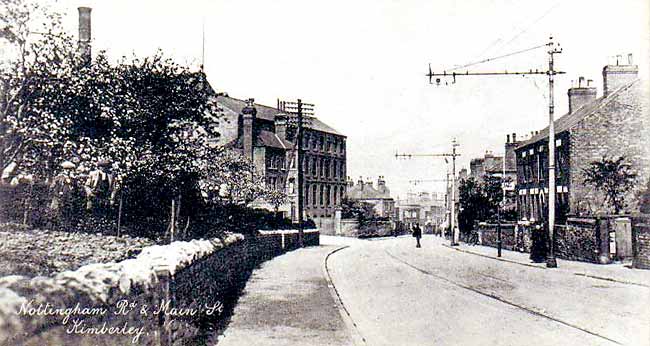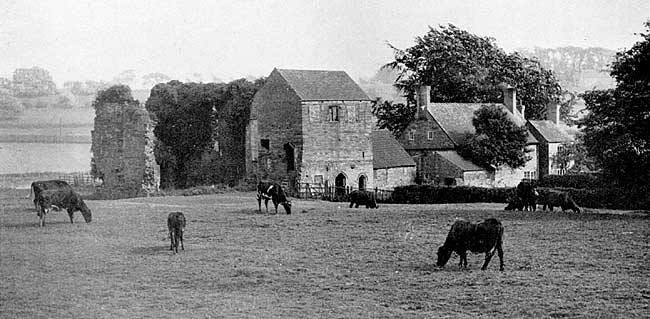Kimberley

Nottingham Road and Main Street, Kimberley, c.1910.
As the Kimberley of to-day is a busy township of some 5,000 inhabitants, it might reasonably be assumed that it has come down the ages as a populous and important village, but the fact is that for centuries until the Victorian era it was nothing more than an undistinguished hamlet of the huge parish of Greasley.
In the 15th century, it could not muster 10 householders; 150 years ago Throsby described it as a large hamlet, which is tantamount to calling it a small village, and barely a hundred years have elapsed since it was officially detached from its mother parish of Greasley.
At that time it was growing fast; mines and mills were being established, a network of railways was about to be constructed around it and the village, then notable for its rustic charms, was on the eve of development into an industrial township.
ITS ORIGIN.
Its name proclaims a Saxon origin. In its earliest known form it appears as "Chinemarleie " and no doubt can be entertained that the final syllable is the Old English 'leah,' a woodland clearing.
Place-name experts agree that the forepart of the name commemorates a Saxon called Cynemaer, but the suggestion tentatively advanced by the Rev. Baron von Hube in his "Griseleia" (1901) that it might be associated with Cynedrith, the wife of the 8th century Offa, King of the Mercians, elicited no support.
As further local information on this obscure period is hardly to be hoped for, Cynemaer may be regarded as the leader of a party of invaders who cleared a modern "lea" (a field) in the great forest which stretched from the Trent into Yorkshire and Derbyshire, where the royal forests of Sherwood and the Peak were formed in later times.
Judging from the Domesday entry the village as the Normans found it was not of much importance for it yielded only 10s. to the geld-tax in 1066 and its value was the same when the Conqueror died.
Hucknall (Torkard) was rendering only 4s in 1087, but Watnall was paying 40s. and Wollaton 100 shillings, though by the close of William's reign, this sum had been reduced to 60s.
Two Saxon thegns, Azor and Grinchitel, each had a manor of four bovates of rather unproductive soil. A parcel of waste land at Newthorpe was a berewick of Kimberley and if the Grinchel of that place may be identified with Grinchitel the berewick would pertain to his manor here.
The Saxon owners were dispossessed and their lands formed a small portion of the enormous grant by King, William to William Peverei, who is sometimes wrongly said to have been his natural son
FALL OF THE PEVERELS.
The survey mentions no church, and the record that the vill supported two sochmen, one villein and five (unfree) bordars seems to indicate that the Danes had taken little interest in it, for to them slavery was repugnant and in their territories bondmen were few.
The Peverel overlordship endured less than a century and ended abruptly as a result of the dynastic war in Stephen's troubled reign. That king usurped the throne in 1135 and when the fifth and last William Peverel entered upon his great inheritance in 1138 he soon distinguished himself as one of the leaders of the royal army at the Battle of the Standard in that year. Then he revolted and his fee was seized by Stephen, but peace was soon restored between them and Peverel fortified Nottingham Castle, fought valiantly for him, was taken captive with him at Lincoln in 1141 and after imprisonment in a dungeon for many months loaded with chains was released by exchange.
He then recaptured Nottingham Castle, which had been taken for Prince Henry, and held it throughout the rest of the reign.
In 1152, while the war was yet being waged, Henry (afterwards Henry II) awarded Nottingham Castle to one of his supporters, Ranulph, Earl of Chester, "if he could get it," but in the ensuing year the earl died. Peverel was accused of causing his death by poison, but, inasmuch as charges of poisoning were at that period recklessly advanced upon the flimsiest evidence, the accusation need not be regarded as any more convincing than the allegations that this lord of Kimberley had compassed his death by witchcraft.
IN MONK'S DISGUISE.
Stephen died in 1154 and when Henry II ascended the throne he demanded the surrender of the Castle, and as this was not forthcoming, he marched to take it by force.
Peverel is said to have fled as the king advanced and to have been shaven and cowled as a monk in Lenton Priory, but, not trusting that disguise, he disappeared, to be heard of no more. Henry took possession of his lands and held them until 1174, when he granted them to his son, the Earl of Mortain—the future King John.
Thus the Peverel line ended, but their barony continued under the name of the Honour of Peverel (in which Kimberley was comprised), and its court leet, known as the Court of the Honour of Peverel, existed until 1849, when it required an Act of Parliament to abolish it.
THE KIMBERLEYS OF KIMBERLEY.
The date of the erection of the church is unknown but it was in existence by 1205, as an entry in the register of Archbishop Romeyn reveals that in this year, Robert de Kinmarley granted the presentation of the living to John de Kinmarley, clerk. A survey of the Honour of Peverel made in 1250 shows that Robt. de Kinmarley then had half-a-caracute of land here worth 20s. per annum for which he paid 10d. yearly for all dues and 18d. to the sheriff's aid.
There appears to have been a cross in Kimberley in the 13th century for a deed of 1270 contains a reference to "le Leves at the cross of William the parson by the road. It was probably a boundary cross which escaped the notice of Mr. Stapleton our chiel authority on the crosses of Nottinghamshire.
By 1271 the Lords Grey of Codnor were the overlords of Kimberley and Robert de Kinmarley was holding from them the "site of the old hall and half-a-caracute of land; he was also the patron of the living. In 1316 Kimberley was accounted the fourth part of a vill and Robert de Kinmarley was its lord, but the days of their ownership were drawing to a close, for in 1335, Robert's son John, a priest, passed the manor and advowson to John de Monte, rector of the mother church of Greasley, together with all his goods.
BEAUVALE PRIORY.

View of the ruins of Beauvale Priory, c.1930.
In 1338, this cleric assigned these properties to Sir Nicholas de Cantelupe, lord of Ilkeston, and in rapid succession the manor passed to Robert Bernak and William de Breydeston, clerk, who settled it upon Hugh de Cressy for life and thereafter upon Beauvale Priory, which Sir Nicholas founded in 1343. Obviously this knight had already determined upon the foundation of the monastery and these transactions have the appearance of being legal preliminaries. Bernak was one of the witnesses to the deed of gift but other rights remained to be extinguished: in 1359 Hugh de Cressy and Cecilia his wife released to Beauvale all their rights and claims in Kimberley and Newthorpe but they reserved to themselves a pension of £7 10s. during the life of Hugh and £4 10s. if she survived him. These benefactions were rounded off in 1360 when Lord Grey licensed Bernak and Breydeston to grant the manor to the clear yearly value of 56s. 5d. to the priory of Beauvale.
MEDIEVAL KIMBERLEY.
Cantelupe land here which did not thus go to the priory descended about 1375 to Sir William la Zouch of Harringworth, who was in possession of it and the castle of Greasley by 1389, and although a passage in the Close Rolls states that in 1411 Henry IV granted the castle with extensive properties in the district to Sir Thomas Berkeley, the manor and advowson of Kimberley were not disturbed, for they were hold from the king as of the Honour of Peverel by Sir William la Zouch at his death in 1416. In 1387 another independent portion belonged to the Hicklings, and in 1399 the king's escheator was commanded to admit Sir William la Zouch to the livery of the castle and manor of Greasley with appurtenances in "Kymerley and Hemeylle " (Hempshill), the King having taken his fealty.
A minor local owner of that time was William de Wollaton, whose holding passed at his death to William and Avice de Schippeley and by them was conveyed to two men of Nottingham named Holt and Arrowsmith.
Coal was being worked on lands belonging to Beauvale Priory.
The appointment of a fresh rector in 1351 hints at a visitation by the Black Death, but the village appears to have escaped te aids and outrages so prevalent in the 14th century, possibly owing to the overawing power of the Lords Grey and the proximity of Greasley Castle; but in 1328 John de Kymerleye, parson of Broughton, was prosecuted for the abduction of John, son and heir of Stephen de Kynmerleye, and at the opening of the next century the rector of Kynmarley had pardon of his outlawry for debt.
HOW KIMBERLEY GREW OUT OF A VILLAGE
In the second half of the 18th century, the coal mines were being worked out, and the making of hosiery became a local industry. The canal was constructed. Kimberley was becoming commercialised, but it was still rustic, and about 1797, Throsby described it as one of the most romantic he had seen in this part of the county; its cottages clustering about the church, which was then a deserted ruin, while others were beginning to straggle up hill and down dale where the 'centre of gravity' presents itself to-day.
It was still picturesque when Laird saw it in 1811—the year when Luddite rioters paid an unwelcome visit and smashed a number of stocking-frames. More riots occurred during the Pentrich rising of 1817 when a mob under "Captain" Brandreth halted at Eastwood upon hearing of the approach of the military.
When Mr. Lancelot Rolleston arrived with soldiers, it was found that the rioters had hastily dispersed, shedding their arms as they fled.
Some were captured and several, including Jeremiah Brandreth, were hanged.
The rise of modern Kimberley dates back to 1816 when the Rutland estate was broken up and sold off in numerous lots, creating a number of new freeholders. Viscount Melbourne —destined to be-Queen Victoria's first prime minister and friend—Robert Holden, of Nuthall, and persons of the names of Godber, Hanson, Smedley, Birkin, and Shaw were among the purchasers.
